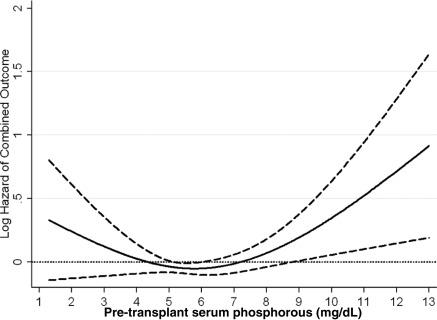Figure 4.
Cubic spline model for the association of pre-transplant serum phosphorus levels with death or graft loss. This figure shows the hazard ratios with 95% confidence intervals of combined outcomes (all-cause of death or graft loss) across the entire range of pretransplant serum phosphorus levels using Cox regression analyses in 9384 long-term hemodialysis transplant patients who underwent renal transplantation and who were observed over a 6-year study period (July 2001 through June 2007). Model adjusted for age, gender, recipient race-ethnicity, diabetes mellitus, dialysis vintage, primary insurance, marital status, standardized mortality ratio of the dialysis clinic during entry quarter, dialysis dose as indicated by Kt/V (single pool), presence or absence of a hemodialysis catheter, and residual renal function during the entry quarter, eight comorbidities, body mass index, nPNA, serum or blood concentrations of TIBC, ferritin, calcium, bicarbonate, peripheral white blood cell count, lymphocyte percentage, albumin, donor type, donor age, donor gender, panel reactive antibody titer (last value before transplant), number of HLA mismatches, cold ischemia time, DGF, and extended donor criteria. Abbreviations: DGF, delayed graft function; nPNA, normalized protein nitrogen appearance; TIBC, total iron binding capacity.

